Legislative Analyst's OfficeAnalysis of the 2003-04 Budget Bill |
The California Department of Corrections (CDC) is responsible for the incarceration, training, education, and care of adult felons and nonfelon narcotic addicts. It also supervises and treats parolees released to the community.
The department operates 33 institutions, including a central medical facility, a treatment center for narcotic addicts under civil commitment, and a substance abuse treatment facility for incarcerated felons. The CDC system also operates 11 reception centers to process newly committed prisoners; 16 community correctional facilities; 38 fire and conservation camps; the Richard A. McGee Correctional Training Center; 32 community reentry programs; a restitution and a drug treatment program; 136 parole offices; and 4 outpatient psychiatric services clinics.
The budget proposes total expenditures of $5.3 billion for CDC in 2003-04. This is $40.2 million, or about 0.8 percent, above the revised estimate for current-year expenditures. The primary causes of this increase are a projected rise in the inmate population and a proposed increase in funding for worker compensation expenses.
General Fund Expenditures. Proposed General Fund expenditures for the budget year total $5.1 billion, an increase of $53.1 million, or 1 percent, above the revised current-year estimate.
Federal Fund Expenditures. The Governor's budget assumes that the state will receive about $154.5 million from the federal government during 2003-04 as partial reimbursement of CDC's costs (estimated to be $556 million in the budget year) for incarcerating inmates in prison and supervising felons on parole who are illegally in the United States and have committed crimes in California. The federal funds are not included in CDC's budget display, but instead are scheduled as "offsets" to its total state General Fund expenditures.
Figures 1 through 5 illustrate the characteristics of the state's prison population, which was 157,979 as of June 30, 2002. About 94 percent of the population is male. The charts show:
The California Department of Corrections is projecting the inmate population to grow slightly in the second half of the current year before stabilizing.
Inmate Population Increase. As of June 30, 2002, the CDC housed 157,979 inmates in prisons, fire and conservation camps, and community correctional facilities. Based on the fall 2002 population forecast prepared by CDC, the inmate count will climb to 160,661 by June 30, 2003, an increase of approximately 2,682 inmates, or 1.7 percent, from a year ago. The inmate population is expected to remain at about 161,000 through 2007.
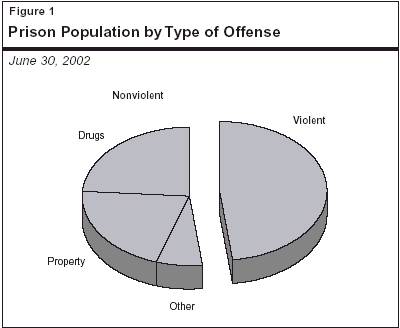
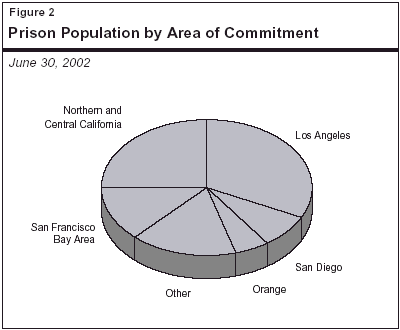
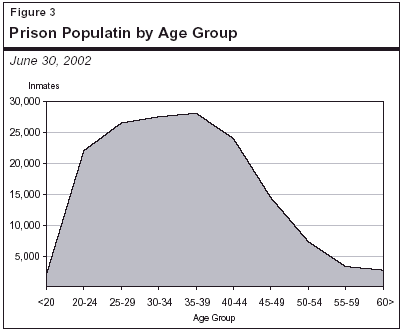
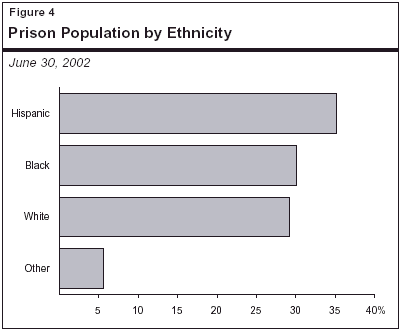
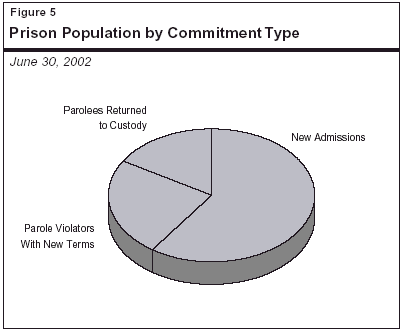
Parole Population Decline. As of June 30, 2002, the CDC supervised 119,360 persons on parole. The fall 2002 projections assume that the parole population will decrease to 117,233 as of June 30, 2003, and further decline to 115,387 by June 30, 2004. This represents a parole population decrease of 1.8 percent in the current year and 1.6 percent in the budget year. The fall 2002 projections also assume that the parole population will continue to fall through 2005 and stabilize at about 114,000 parolees through June 30, 2007.
Change From Prior Projections. The fall 2002 projection of the inmate population has increased from the prior CDC forecast (spring 2002), which was the basis for the 2002-03 Budget Act. The new fall 2002 forecast for June 30, 2003 is about 3,330 inmates higher than the spring forecast. As can been seen in Figure 6, the department's spring estimate assumed significant growth over the projection period, whereas the fall projection assumes the inmate population will remain stable.
The fall 2002 projection of the parole population shows a slower rate of decline than the spring 2002 projections. Although there is no difference in the projections for June 30, 2003, as can be seen in Figure 7, the projections widen over the projection period until the differential exceeds 6,200 at the end of 2007-08.
|
Figure 6 Total Inmate Population Recent CDC Projections |
|||
|
June 30 Population |
Projection as of: |
Difference |
|
|
Spring 2002 |
Fall 2002 |
||
|
2003 |
157,331 |
160,661 |
3,330 |
|
2005 |
159,868 |
160,940 |
1,072 |
|
2007 |
166,473 |
160,578 |
-5,895 |
Why the Forecasts Changed Between Spring and Fall 2002. According to CDC, three factors appear to have caused the inmate population to increase during the current year. On July 31, 2002, the inmate population surged by 1,150 prisoners from the month before because Los Angeles County reduced the number of state prisoners it was willing to hold in county jails under its local assistance contract. In addition, a Board of Prison Terms (BPT) backlog in Proposition 36 cases resulted in fewer inmate diversions to local treatment programs than previously anticipated. Finally, according to the CDC, fewer parole violators were returned to prison by administrative actions of the Board of Prison Terms.
|
Figure 7 Total Parole Population Recent CDC Projections |
|||
|
June 30 Population |
Projection as of: |
Difference |
|
|
Spring 2002 |
Fall 2002 |
||
|
2003 |
117,233 |
117,233 |
— |
|
2005 |
111,024 |
114,305 |
3,281 |
|
2007 |
107,681 |
113,937 |
6,256 |
Potential Risks to Accuracy of Projections. As we have indicated in past years, the accuracy of the department's latest projections remain dependent upon a number of significant factors. These include:
Significant changes in any of these areas could easily result in a prison growth rate higher or lower than the one contained in CDC's projections.
We withhold recommendation on the 2003-04 budget request for caseload funding. Recent data indicate that the population is trending slightly lower than the department's projections. As a result, inmate population may be slightly overstated in the current and budget years. We will continue to monitor the caseload and recommend further changes, if necessary, following review of the May Revision.
Actual Inmate Count Is Slightly Lower Than Fall Projection. The fall 2002 projection anticipated that the prison population would increase by about 1,800 inmates during the first half of 2002-03 relative to the prior year. Instead, it increased by about 1,500. According to the CDC, this lower than anticipated population increase is attributable to a lower than anticipated number of parolees returned to custody, and more inmate releases from conservation camps due to the recently implemented doubling of work credits pursuant to Chapter 1124, Statutes of 2002 (AB 3000, Committee on Budget).
Current-Year Effect. Based on the inmate population as of the end of December 2002, we estimate that the average daily population of the prison system in 2002-03 will be about 630 inmates below the caseload assumed in the Governor's budget plan. We further estimate that the average daily parole population will be about 624 parolees lower than the caseload assumed in the Governor's budget plan. The net effect of these two changes would be a decrease in current-year costs of about $8.7 million.
Budget-Year Effect. The CDC forecast assumes that inmate population will increase by 378 between the current and budget years. Although the recent data suggest inmate population may be stable in the budget year, there is uncertainty as to how much Proposition 36 diversions will be affected by recently adopted CDC/BPT referral procedures for moving parolees into county drug assessment centers. Furthermore, at this time, we are unable to gauge the effect that increased work credits for conservation camp inmates is likely to have on average daily population.
The CDC will issue updated population projections in spring 2003 that form the basis of the department's May Revision proposal. At that time, we will review whether adjustments to CDC's funding for inmate and parole caseloads are warranted.
Analyst's Recommendation. We withhold recommendation on the 2003-04 caseload funding request. We will continue to monitor CDC population, and make recommendations as appropriate at the time of the May Revision.
The California Department of Corrections currently has approximately 6,400 inmates over the age of 55. Elderly inmates are costly to care for, yet research indicates that many of these older inmates represent a relatively low risk of reoffending and show high rates of parole success. Given the state's current fiscal condition, we believe the Legislature should adopt budget trailer bill language requiring early discharge to parole for nonviolent older inmates. We estimate that such a policy would result in state savings of approximately $9 million in the budget year, and significantly more in the out-years without jeopardizing public safety. (Reduce Item 5240-001-0001 by $9 million.)
Background. Inmates 55 years of age and older are becoming a larger part of the CDC's institutional population. Currently, approximately 3,509 inmates are between age 55 and age 59, 1,621 inmates are between age 60 and 64 years of age, and 1,267 inmates are 65 years or older. Because older inmates tend to have more significant medical problems, the graying of CDC's population has serious long- and short-term General Fund implications. Last year, we discussed releasing nonviolent, elderly inmates to parole as one of the Legislature's options for addressing the state's fiscal problem. This analysis provides additional information on the cost of housing older inmates in California prisons, and discusses research related to elderly inmates and their likelihood to reoffend.
Elderly Inmates Two to Three Times More Expensive. While CDC agrees that housing elderly inmates in California prisons is more costly than housing younger prisoners, it could not provide specific information on how much it costs to house elderly inmates. This is because the department does not collect data on this specific group of inmates. However, our review of correctional operations in other states, as well as other research on this topic, indicates that elderly inmates cost as much as two to three times the amount required to house younger inmates. New York, for example, estimates an average annual cost to house elderly inmates of $50,000 to $75,000, which was twice that state's average for a younger prisoner. Although no figures were available, in 1997, the Texas Criminal Justice Policy Council concluded that Texas paid nearly three times as much to provide health care to elderly inmates as it paid for the general prison population. Finally, the National Center of Institutions and Alternatives estimates the national average yearly cost of confining elderly inmates is approximately $69,000, over three times the national average of $22,000 to incarcerate ordinary inmates.
Why Are Elderly Inmates Expensive? As one might expect, the higher cost of housing elderly inmates is driven by the special needs brought about by age, similar to the needs of many aging adults in society. These special needs range from the need for eye glasses and hearing aids to the need to address more frequent health care episodes, and treatment for chronic disease and fatal illness. Elderly inmates also require special facilities accommodations, such as special commodes and showers with handrails. Many elderly inmates will ultimately require constant bed care and intensive medical supervision.
In addition to the special needs that generally come with aging, there are some unique factors about prison that make housing elderly inmates potentially more costly. First, inmate demographics and prior life styles probably result in a concentration of individuals more prone to certain health conditions such as diabetes, heart disease, and hepatitis. Second, the full cost of prison health care services is borne by the state, rather than shared as in an insurance program. Third, the cost of prison health care services is accompanied by the cost of guarding the inmate while services are delivered. This is particularly an issue when the inmates need to be transported to an outside facility for medical treatment. Fourth, CDC is not equipped to effectively manage the health care needs of elderly inmates. For example, the department does not have a chronic care management program for elderly inmates that might allow it to prevent some inmates from requiring expensive medical treatment.
Are California Prisons Equipped to Handle Elderly Inmates? Nationwide, most correctional institutions are poorly positioned to cope with the health and housing needs of aging and geriatric prisoners. For example, California, like most other states, generally does not have facilities specifically designed or operated to meet the needs of elderly inmates. Moreover, California, like other states, relies on a sick-call system originally conceived to treat common illnesses like flu, wherein correctional officers who, except for medical technical assistants (MTAs), typically have little or no medical training, are generally the first to take note of an aging inmate's medical problems. Then, doctors and nurses—many with little training or experience in treating age-related illness—must handle dozens of these and other cases with very limited time per patient.
Another problem for California is it, like most other states and the Federal Bureau of Prisons, has no official inmate classification based on age. From a budgetary perspective, the classification system's failure to track prisoners by age precludes the kind of analysis that would flag spikes in the costs to care for elderly inmates or suggest alternative management strategies such as relocation to reduce transportation costs or dedicated housing to take advantage of economies of scale.
By 2022, we estimate the elderly inmate population will be approximately 30,200, or 16 percent of the total CDC population. Preparing California's prison system for this number of elderly inmates will likely be extremely costly. This is because, it would likely involve facility renovations, as well as a change in the manner in which health care is delivered, and potentially expensive treatments for such age-related illnesses as cancer and heart disease.
Criminal Behavior Declines With Age. Criminologists have long known that the propensity to commit crimes declines with age regardless of sex, race, ethnicity, or offense. Figure 8 shows that nationwide, arrests in 1999 peaked between the ages of 15 to 25, dropped dramatically for offenders 25 to 40, and were fewer than 5 percent among individuals 50 years of age and older. If reducing crime is the goal, the data suggest that imprisoning a 55-year old will have much less of an effect than imprisoning a 20-year old.
Perhaps the most important consideration related to early release of an elderly inmate is the possibility that he or she will commit additional crimes in the future. According to one federal study, 45 percent of inmates released from prison between the ages of 18 and 49 were likely to commit another crime and end up back in prison. By comparison, only 3.2 percent of those released over the age of 55 got in trouble with the law. In addition, a 1995 U.S. Department of Justice study tracked a cohort of parolees released in 1991. As Figure 9 shows, the study found that recidivism varies sharply by age group. In particular, this study indicated that older parolees are reincarcerated very infrequently, as only 1.4 percent of parolees 55 years and older recidivated.
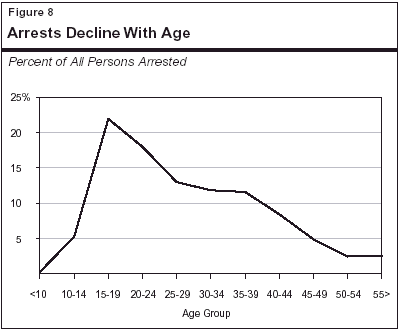
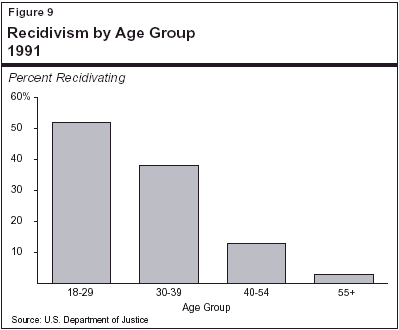
Benefits of Early Release to Parole for Nonviolent Elderly Prisoners. Our analysis suggests that housing nonviolent elderly inmates in prison is not a good use of scarce resources since they are potentially very expensive, yet represent a relatively low risk to society. In addition, as discussed above, research indicates that older inmates tend to be more successful on parole than younger parolees.
Early release of nonviolent and nonserious elderly inmates to parole offers the state a variety of short- and long-term benefits. Based upon information provided by CDC, we estimate there are approximately 250 elderly inmates who would be considered nonviolent and nonserious offenders. Releasing these inmates to parole would generate General Fund savings of approximately $9 million in the budget year. It also represents a potentially significant cost avoidance because it would reduce the need to make expensive infrastructure accommodations. Finally, given the estimated growth of CDC's elderly population and the recent upward spiral in medical costs, this proposal could yield significant long-term General Fund savings to the extent that it reduces the likelihood of court-imposed health care mandates for elderly inmates.
Analyst's Recommendation. Given the high cost of housing nonviolent elderly inmates, relatively low rates of reoffense by elderly inmates, and research showing high rates of parole success among older inmates, we recommend the Legislature release nonviolent inmates over 55 years of age to parole. In addition to savings of approximately $9 million in the budget year, this would reduce prison health care costs, and reduce prison overcrowding, thereby increasing the level of safety in California prisons.
We recommend that the Legislature adopt trailer bill language to allow inmates in the reception centers and inmates involuntarily unassigned to earn day-for-day work credits. This would save the General Fund $70 million in the budget year, and would give the department an increased ability to manage inmate behavior, thereby potentially increasing institution safety. (Reduce Item 5240-001-0001 by $70 million.)
Background. State law requires the CDC to apply work credits to all qualifying inmate assignments including full-time work and elementary, high school, or vocational education programs. In addition, some 5,700 inmates participating in substance abuse treatment programs with half-time work components accrue work credits. The CDC data indicate that systemwide nearly 87,000 inmates—or 82 percent of the inmates who are work-credit eligible—are currently assigned full-time placements. At the time this analysis was prepared, the Senate and Assembly had adopted legislation to increase work credits for certain nonviolent inmates as part of the mid-year budget reduction package.
Work Credit Eligibility. Under current law, eligibility for work credits varies depending on the crime, the date it was committed, and previous felony convictions. In general, the credit system is structured to allow inmates convicted of nonviolent felony offenses to earn the greatest sentence reduction and inmates convicted of violent felonies to earn the least. Some inmates convicted of violent felonies are not eligible for work credits. Specifically, statute limits or prohibits work credits as follows:
State law also provides for forfeiture of work credits as the result of serious disciplinary infractions, but allows CDC to restore credits after a period of not more than one year free of disciplinary problems. Because credits can have such a significant bearing on an inmates' length of confinement, statute requires the department to provide both a hearing and a multilevel appeal before revoking work credits. The appeal process is staff intensive and time consuming for the CDC, but often results in the restoration of lost inmate credits.
Maximum Credit Not Available to Unassigned and Reception Center Inmates. When work credits went into effect in 1983, the Legislature's objective was that, consistent with security and department resources, eligible inmates would have a reasonable opportunity to reduce their prison stays by 50 percent, or the maximum of day-for-day credits earned from full-time work or education assignments. Most inmates, however, can expect to lose up to one month of work credit time both when they are housed at prison reception centers and when they are placed on work assignment waiting lists. Until they have completed their reception center processing and are assigned to full-time, work-credit-qualifying slots, inmates earn work credit at a rate of 33 1/3 percent—or one credit for every two days they spend waiting.
Many inmates wait months to earn maximum work credits. For example, CDC data indicate that as of January 2003 about 13,000 inmates were being processed in reception centers, and 16,000 were unassigned. The average inmate takes from 60 to 120 days to process out of the reception center. The department was unable to provide an average time an inmate might stay on the unassigned list because of the wide variation from prison to prison. We do know, however, that for every 30 days an inmate is housed at a reception center or awaits a full-time assignment he loses five days of work credits relative to what he would have earned in a full-time job or education placement. Based on discussions with departmental staff, they indicate that delays in reception center processing and work and education assignments frequently result in inmate appeals. From the state's perspective, these delays represent millions of General Fund dollars to fund tens of thousands of potentially avoidable incarceration days.
Governor's Budget Proposal May Reduce Work Credit Availability. Nearly 28,000 inmates earn work credits through some type of vocational or academic training including Adult Basic Education, GED preparation, Literacy Programs, and a variety of vocational preparation programs. The 2003-04 Governor's Budget proposes to reduce spending on academic and vocational training by $46 million, thereby potentially reducing the availability of work credits. At the time this analysis was prepared, the administration had not provided any details on its proposal. According to the department, inmates whose academic and vocational slots are reduced by these actions will not lose their ability to earn work credits at the maximum rate. However, because the department was unable to provide details on the governor's reduction proposal, there is no way to estimate whether it will contribute to the department's educational assignment delays or increase prison stays. As such, reducing spending for education programs could potentially result in General Fund costs if inmates lose their ability to earn credits.
Benefits of Day-for-Day Work Credit for Reception Center and Unassigned Inmates. Last year, in our Options for Addressing the State's Fiscal Problem publication, we proposed that the Legislature consider amending current law to increase the work credit earnings rate from 33 1/3 percent to the maximum 50 percent rate for nonviolent inmates housed in reception centers and inmates waiting for a work assignment. According to the department, this proposal would save $70 million (General Fund) in the budget year while reducing the prison terms of more than 29,000 prisoners by an average of only 27 days. In addition, most if not all of the inmates who would gain work credit time under this proposal are serving relatively short sentences (an average of five months) for nonviolent and nonserious offenses.
We believe our proposal has a number of short- and long-term benefits. In particular, it would reduce CDC's operational costs by shortening prison stays and generate an estimated $70 million General Fund savings in the budget year. It would also alleviate serious reception center overcrowding which has been an ongoing problem, and possibly allow the state to delay future construction costs. In addition, we believe these enhanced work credits will provide an incentive for reception center inmates to modify antisocial and criminal behavior. Currently, CDC can reduce an inmate's credits for serious misconduct. Increasing the work credits should provide inmates a greater incentive to comply with CDC guidelines because they have more at stake. Finally, by eliminating the basis for the numerous inmate appeals that require large commitments of expensive correctional staff time, this proposal will likely reduce CDC's appeals-related workload.
Analyst's Recommendation. For the reasons discussed above, we recommend the Legislature adopt trailer bill language to allow inmates in reception centers and those who are involuntarily unassigned to receive day-for-day work credit. In addition to savings of approximately $70 million in the budget year, this proposal would reduce prison overcrowding, help reduce inmate violence by providing a greater incentive for good behavior and, in doing so, potentially contribute to institutional safety.
The Governor's budget assumes that the state will receive $154 million from the federal government for the costs of incarcerating undocumented felons. There is considerable uncertainty regarding this assumption because neither the President's 2002-03 budget nor the 2003-04 budget—released earlier this month—includes funding for this program.
The Governor's budget assumes that the state will receive $154.5 million from the federal government during 2003-04 as partial reimbursement of CDC's cost of incarcerating inmates in prison and supervising felons on parole who are illegally in the United States and have committed crimes in California. Last year, we cautioned that the $208 million in federal funds that the 2002-03 Governor's Budget assumed the state would receive to incarcerate undocumented felons was risky because funding was not included in the President's 2002-03 budget. Moreover, it represented a federal funding level that had never been achieved in the history of the State Criminal Alien Assistance Program. To date, California has not received any of the anticipated 2002-03 federal funding because Congress has not enacted an appropriations bill for the U.S. Department of Justice. Although this year's proposed funding level is more consistent with historical federal appropriations, we note that the President's 2003-04 budget proposal, released earlier this month, does not propose funding for this program.
The scheduled opening of a new mental health facility at Salinas Valley State Prison has been delayed repeatedly due to construction problems. We recommend that the current-year budgets of the Departments of Corrections (CDC) and Mental Health be adjusted to reflect the savings of at least $1.5 million in operating costs for the new facility that will result from the delay in its activation. We further recommend that an additional $100,000 in funding for CDC operating expenses be deleted because it is unclear why these resources are needed at this time.
We discuss our findings and recommendations in regard to this issue in our analysis of the Department of Mental Health budget, which can be found in the "Health and Social Services" chapter of this Analysis.